For Antonin Khalifé, a grandson of the founder of the French perfumery Henry Jacques, traditional men’s fragrances are infused in the culture of the Middle East in ways not seen in other parts of the world. Perfumes, oils and colognes are not only part of the daily ritual of cleanliness but also present in family life and even prayer.
Mr. Khalifé’s training as what the industry calls a nose — skilled professionals who can identify the most subtle of scents — has lately had him focused on the Middle East, which many see as the current global epicenter of fragrance development for men.
For him, it is all about mixing and matching scents.
“Raw materials like frankincense, opoponax and oud, all of them very rich and resinous, have always been really a part of the Middle East, but now you have a bit more of the powdery fragrances from France and something a little more floral at times,” said Mr. Khalifé, who studied at ISIPCA, the graduate school renowned for training “noses” in perfume, cosmetics and food, in Versailles, France. “And over the years, I have seen fewer barriers in terms of tastes. People, especially young people, are starting to wear very different fragrances with different types of profiles.”
Among the traditional fragrances for Gulf region men, frankincense, made from the sap of the local boswellia tree, is ever-present in homes, hotel lobbies and as a perfume or cologne. The finest frankincense is often considered to be from Oman and Yemen, its next-door neighbor.
The post Men’s Fragrances Perfume the Middle East appeared first on New York Times.




